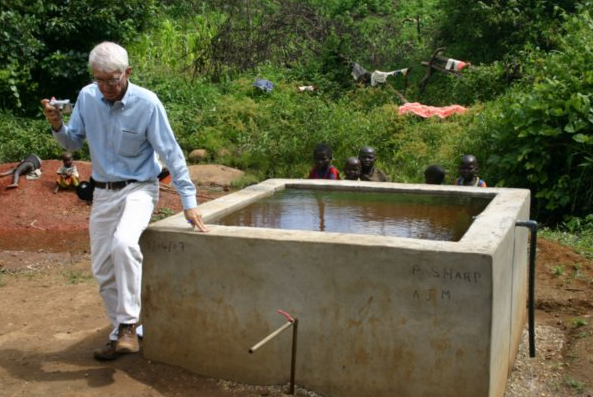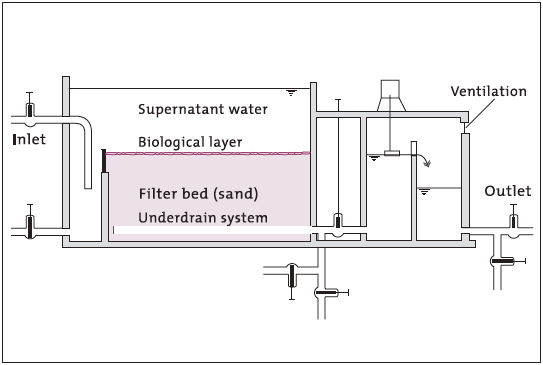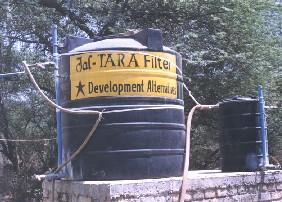Slow sand filter
| |
|
|
|
|
|
|
|
|
|

The slow sand filter ensures a simultaneous bacteriological and physical improvement in water quality comparable to the natural percolation of water through underground strata. Jal-TARA is standardized in 1000 litres water tank with the output water supply of 2500 – 3000 litres per day. The filters contain pebbles and sand of different sizes. System is provided with a synthetic fabric filter designed with advanced technique of fabric protection. The system can be fed under gravity flow or through conventional pumps or operated by solar photo-voltaic.
Contents
Suitable conditions
Slow sand filters are more suitable for low-turbidity water or water that has been pre-filtered. They are used to remove algae and microorganisms, including protozoa, and, if preceded by microstraining or coarse filtration, to reduce turbidity (including adsorbed chemicals). Slow sand filtration is effective for the removal of some organics, including certain pesticides and also ammonia.
| Advantages | Disadvantages |
|---|---|
| - Improves water clarity substantially - Requires no chemicals |
- Requires ascertaining the quality of the raw water and normally cannot be applied to water at low temperatures, with high turbidity levels and/or very low nutrient levels - An attitude change might be needed (belief system that water is not clean without chemicals) |
|
|
Construction, operations and maintenance
The top 5 to 10 cm of wet sand must always be under oxygen rich water. Therefore, the system needs continuous water flow
Large and fine particles of suspended matter are deposited on the surface of the filter bed by the action of mechanical straining and sedimentation, respectively. The colloidal and dissolved impurities are removed by adsorption, whilst the organic matter is converted into organic salts by the purification mechanics. The filtered water is collected at the bottom via pipe system. Most microbiological action takes place in the ‘Schmutzdecke’ (bio film) formed in the fabric filter at the top of the sand bed.
Filter can be easily assembled locally available material like sand, pebbles and water tank. However, fitting material can be easily transported, if not available locally.
TARA Environment Monitoring Facility also manufactures filters which employ the SSF technique. In this case, customers in addition require a water pump to fill the overhead tank and power supply to pump water into the tank - an electricity connection or generator.
Maintenance
The system is designed to have very little maintenance. The filter does require regular cleaning, thought the frequency depends on input water quality (turbidity and bacteria contamination) and filtration rate. Cleaning operation includes cleaning of fabric filter and top sand layer. Fabric filter requires cleaning twice in a year for turbidity 10 – 15 NTU input water. To simplify cleaning operation, backwashing facility is also provided. User’s instruction manual with illustrative diagrams is provided. After maintenance, filter bed should be kept level.
Estimated Lifespan
The filter element could produce up to 7.000 litres (enough for a large family for 1 year) of water before replacement. The plastic parts last up to 5 years.
Costs
| Capital cost | Operating cost | Replacement cost | Estimated 5 year cost | Cost / metre cubed treated |
|---|---|---|---|---|
| Rs. 80.000 = ~ € 1.300 | € 500 O&M lifetime + € 100 salary /year | € 2/year | € 0,68 |
These costs assume the lifetime is 15 years with daily production of 2.750 litres; O&M and salary included; salary is based on 1 working day of operator, assuming an average gross annual income of € 500 in developing countries.
Manuals, videos, and links
- Video #1: A quick look at roof water harvesting using a slow sand filter combined with a diverter. This is an overview of the procedure and a demonstration of a working system.
- Video #2: How to build a slow sand water filter using a 55 gallon barrel. This shows the actual assembly of a slow sand filter very similar to the one shown in the first video.
with a slow sand filter |
a slow sand filter: PART 2 |
Acknowledgements
- Guidelines for Drinking-water Quality. or (alternative link). Fourth edition. WHO, 2011.


